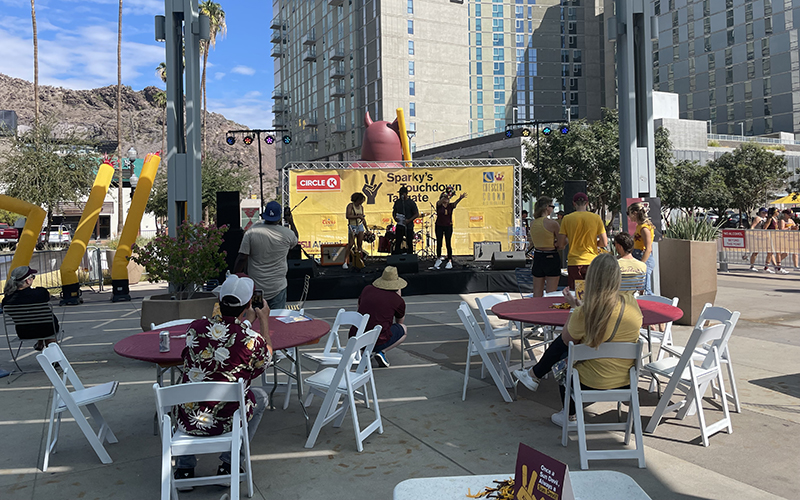TEMPE – Colorful skies, mountain views and a sea of maroon and gold shirts provide a picturesque backdrop for Arizona State football games.
Yet, despite the scenic atmosphere, ASU fans in recent years have expressed disappointment with the overall game day experience. A 2017 survey of more than 500 fans by Cronkite News revealed that 71.5 percent were dissatisfied with the atmosphere.
Now, five years later, those concerns continue to be addressed with improved stadium access and better pregame and in-game festivities as the school hopes to lure fans despite a 3-7 record and a head coaching change. Average home attendance in 2022 is 43,787, 81% of its capacity of 53,599. In 2021, ASU ranked 39th overall in attendance among Division I Schools with 47,248 fans per game.
“It’s definitely better,” said Jordan Wells, 28, who said he has come to ASU football games with his family for years. “The concourses are better. I just wish we had a tailgate environment like some other Power 5 schools.”
Following each season, the team sends a survey to fans about the game day experience, said Mike Meitin, ASU’s senior associate athletic director of ticketing.
Meitin is one of the figures responsible for the improvements seen at Sun Devil Stadium, where ASU will host Oregon State Saturday, but work remains in three key areas, fans say: the on-field product; pregame, in-game and post-game experiences; and kickoff times.
When fans complained of long lines to enter the stadium in 2018, Meitin implemented new metal detectors and a digital ticketing system that tripled the entrance speed into the stadium, he said.
“You already improved somebody’s game day because they don’t have to worry about getting stuck in a long line,” Meitin said. “They can stay at their pregame party a little bit longer if they want to.”
Last year, many fans complained about long wait times in concession lines. Meitin saw another opportunity for change, implementing a new point-of-sale system, going cashless and adding additional portable beverage stations.
“We don’t have all the data yet, but all indications show that the lines are shorter and going faster,” Meitin said. “So we’ll do that survey again here at the end of the year and see what we need to focus on for next year.”
“I think with the stadium being refurbished and redone, it’s a lot better atmosphere than it was. There’s more walking space,” said Doug Tammaro, senior associate athletic director, media relations. “Sometimes you look and you see people, not in their seats, and sometimes those people are out on the concourse walking around, enjoying the concourse that we built for people to buy beer.”
Although these changes are decreasing fans’ stress levels during the game, Meitin is also working on improving the pregame experience at Sun Devil Stadium. Recently, ASU football lost some parking spaces surrounding Sun Devil Stadium due to the construction of Mullett Arena, a 5,000-seat facility designed to host ASU hockey, gymnastics and wrestling, and is also hosting the NHL’s Coyotes.
ASU began searching for innovative ways to use available space. It implemented a new indoor-outdoor tailgate on the North Plaza of Desert Financial Arena to go along with the Coors Light tailgate at Desert Arboretum Park. Everything at the tailgate costs $4 and the site is fully equipped with air conditioning, bars and grills, outdoor games and televisions.

Former ASU linebacker Brandon Magee is among those who have been featured at the Sparky’s Touchdown Tailgate near Sun Devil Stadium. (Photo by Aayush Gupta/Cronkite News)
On the south side of the arena, Meitin and the Sun Devils have partnered with RevelXP, a fan experience and hospitality company, to provide a tailgate rental service. RevelXP sets up the tent, coolers, and TVs for tailgaters, so “you’re getting a much better experience because you don’t have to deal with any of the hassles,” Meitin said.
Interim coach Shaun Aguano has also had an impact on the changes. In an attempt to get fans excited about ASU football, Aguano brought back the Sun Devil Walk, which features players and coaches walking around the outside of Desert Financial so they can interact with fans en route to Sun Devil Stadium. Before a recent game against the Washington Huskies, the Devil Walk was crowded with families cheering on the team.
Tim Moriarty, an ASU police officer for 23 years, said he is excited about the direction of ASU football.
“Being on the inside here is new for me, so a lot of the stuff is new,” Moriarty said. “But over the years, I’ve seen the game day experience grow in numbers.”
Meitin would agree.
“The team and the coaching staff have been phenomenal with the fans,” he said. “It’s the kind of thing I’m interested in seeing how it grows. It’s not exactly where I think it could be right now, but I think it’s exceeded everybody’s expectations for something that’s brand new and just brought back.”
More changes
Although changes to the game-day experience provide more entertainment options, the on-field product also impacts how fans feel. From a head coaching change to a quarterback controversy, the 2022 season has been a tumultous one.
Many fans have left the stands at halftime due to poor performances on the field. Riding a four-game losing streak, it was no shock that ASU’s win over Washington on Oct. 8 was the lowest-attended game this season at 39,244.
Tammaro pointed to fall break, adding, “It was an afternoon kick, and we were 1-4.”
“Let’s be honest, people go to games when we are winning,” he said. “We had a fantastic atmosphere for Oregon in 2019, but sometimes people just aren’t coming to a game because of game time. Some people can’t make it at 1 p.m game time.”
The Pac-12 tries to avoid early season daytime kickoffs in Arizona because of the heat. However, in 2019, games against Oregon, USC and Arizona had an attendance of over 50,000 to provide a must-see atmosphere. USC and Arizona tend to bring the most fans to the stadium, Tammaro said, and not having them on the home schedule this season will hurt overall attendance numbers.
With just two weeks left in the 2022 season, the Sun Devils hope to finish strong and set a positive tone for 2023.

